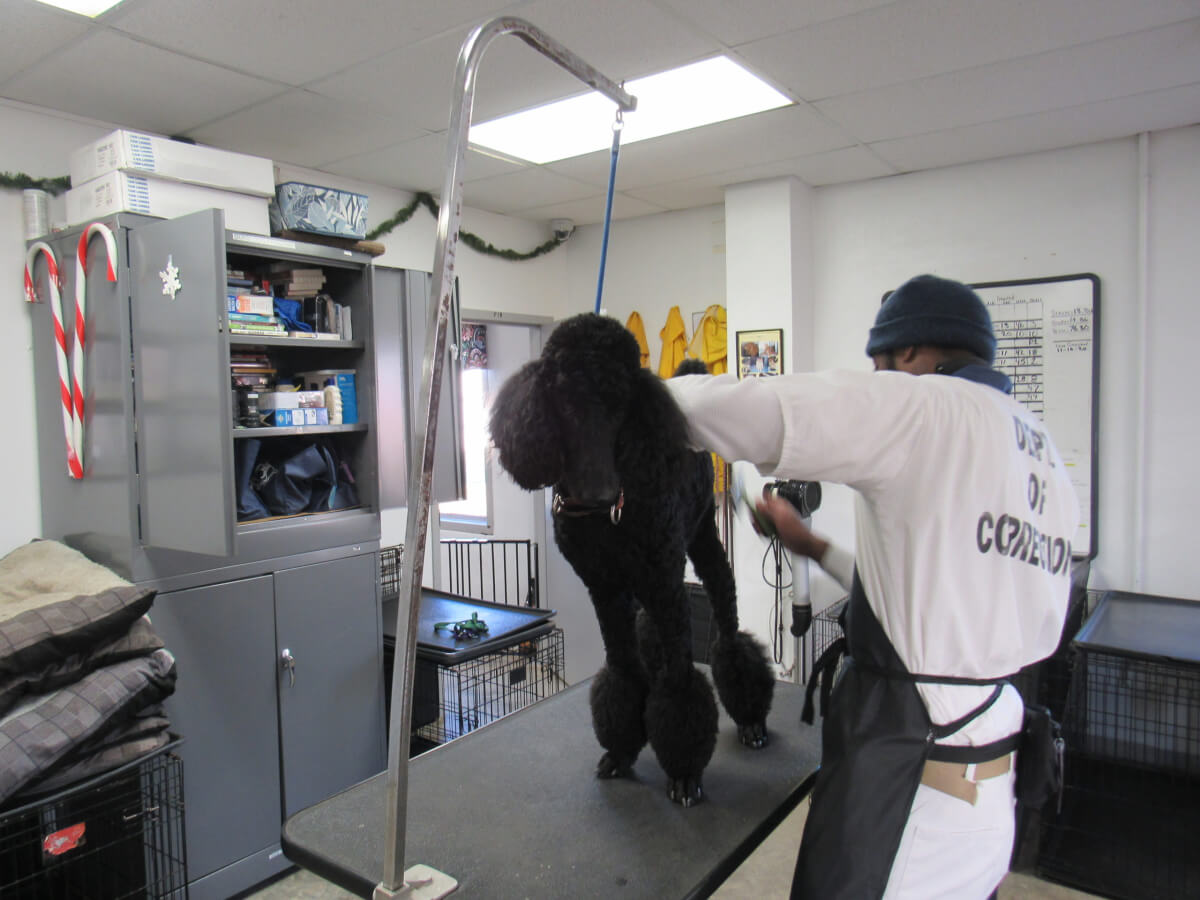
Pawsitive programming
Local inmates train guide dogs for blind people
By Jane Winston
In early February, a litter of three pups arrived at the Burruss’ Correctional Training Center (BCTC) in Forsyth. They joined five other dogs and began their 18-month journey through the Vision Guide Dog Program where they live and learn, together, how to become the best guide dogs.
The Guide Dog Foundation for the Blind, (GDF) a nonprofit organization in New York, provides the dogs, which are bred specifically in Long Island, New York, to become guide dogs. It costs more than $50,000 to breed, raise, train and place one assistance dog.
They arrive at Burrus and multiple other destinations via plane, train and automobile. Those who fly actually have their own flight attendant assigned to them. These attendants have special licensing and are stationed all over the US.
In 2008, the GDF chose the Burruss Center to host its guide-dog training program for several reasons. One, it is adjacent to the Georgia Public Safety Training Center, which uses Burruss’ inmates for various details. As a result, BCTC inmates generally have good institutional records and are able to meet the qualifications for the Vision program.
Another benefit is that the Department of Corrections headquarters is located nearby at the former Tift College campus and brings many visitors to the area and to visit Burruss. These visits are good for the dogs and tend to generate support for the program.
Also supporting the program is Purina, which donates the dog food, and Central Georgia Technical College (CTCG), which provides the inmates the opportunity to earn certification through virtual courses taught by a veterinarian. Pet first aid, CPR, grooming, animal caretaking and dog training all come together to provide the inmate with a veterinary-helper certificate.
“It’s the best job you can have in the prison, training a dog and giving back to someone,” one inmate said.
To be eligible for the program, an inmate must be 18, a high school graduate or hold a GED. Their crime type may preclude participation in the program, and the applicant must have a positive disciplinary record. Before final selection, the inmate is interviewed and writes an essay focused on why he wants to be a dog trainer, and why he feels he should be chosen.
Once selected and paired with a dog, the training begins. The dogs live with strict rules and regulations. For instance, they are not allowed snacks nor are they to pick up any items. They don’t sit on furniture or beds, and they are trained to relieve themselves on concrete with the command, “go busy.”
Grooming the dog is another inmate responsibility. They brush the dog, brush the dog’s teeth, clean its ears and bathe it. Socialization is also an important part of the training. As a result, the trainer keeps the dog with him throughout the week, totaling about 15 hours a day including class time. However, come bed time, the dogs go to their kennel/classroom for the night with an aide on duty.
Inmates develop close bonds with the dogs: “The dogs are joy wrapped in fur and give back more than I ever imagined.”
Lundianne Johnson, Burruss Guide Dog Program and Guide Dog Foundation area coordinator and classroom instructor, has been at BCTC for 13 years. She derives great pleasure from her job, the dogs and the inmates.
“The inmates get to love and be loved by their dog. They feel a sense of purpose and are able to put the prison out of their minds for a portion of their day. Plus, they earn certificates and credit hours that are beneficial in finding employment when they leave the facility, and the recidivism rate among those in the program at BCTC is nonexistent.”
As one trainer/inmate said, “You can’t become a better trainer without becoming a better person. The dog has helped me as much as I have helped him.”
Since the program began 13 years ago, nearly 200 inmates have participated and 95 dogs have been raised full time. Twice that many have come for short stays as part of their overall training.
“Over 70 percent of the dogs trained at BCTC graduate,” Johnson said. “Obviously, some dogs can’t complete the program due to medical reasons or extreme behavior issues and are adopted by their weekend raisers or other families. Some experience a ‘career change,’ as we find they are better suited to be bomb-sniffing dogs, Post Traumatic Syndrome dogs, police dogs or some other type of service dog.”
At the end of the 18 months, there is a graduation for the dogs and inmates. The dogs and trainers say goodbye to one another, and the dogs go back to the Guide Dog Foundation for the Blind in New York. Burruss’ well-disciplined and well-trained dogs are welcomed and enter the last leg of their journey, a 12-week orientation and mobility training.
During this time, the dogs previous training is fine-tuned, as they learn the complexities of how to actually guide a visually-impaired individual. Once the dog satisfactorily completes the course, it is carefully partnered with a visually-impaired individual, at no expense to him or her, and together they begin the final step with one more week of additional training.
A grateful inmate sums up his experience: “This program has given me the opportunity to improve myself through education and the love these dogs provide. Knowing the hard work that goes into making the lives better for both dog and disabled person brings me real joy. I am very thankful that this worthwhile program is here at Burruss, and that I was able to be part of it.”
Coming next: We’ll take a deeper look at the weekend trainers and their roles in shaping the dogs’ future in the Vision Guide Dog Program.







